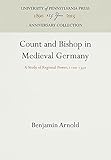Count and Bishop in Medieval Germany : A Study of Regional Power, 1100-1350 / Benjamin Arnold.
Material type: TextSeries: The Middle Ages SeriesPublisher: Philadelphia : University of Pennsylvania Press, [2016]Copyright date: ©1992Edition: Reprint 2016Description: 1 online resource (256 p.) : 10 illusContent type:
TextSeries: The Middle Ages SeriesPublisher: Philadelphia : University of Pennsylvania Press, [2016]Copyright date: ©1992Edition: Reprint 2016Description: 1 online resource (256 p.) : 10 illusContent type: - 9780812230840
- 9781512800104
- 320.943 20
- JN3249
- online - DeGruyter
- Issued also in print.
| Item type | Current library | Call number | URL | Status | Notes | Barcode | |
|---|---|---|---|---|---|---|---|
 eBook
eBook
|
Biblioteca "Angelicum" Pont. Univ. S.Tommaso d'Aquino Nuvola online | online - DeGruyter (Browse shelf(Opens below)) | Online access | Not for loan (Accesso limitato) | Accesso per gli utenti autorizzati / Access for authorized users | (dgr)9781512800104 |
Frontmatter -- Content -- Abbreviations -- Illustrations -- Preface -- Introduction: Land and Lordship in the Medieval German Empire -- 1. Regions and Political Power in Medieval Germany -- 2. The See of Eichstätt and Its Neighbors -- 3. Counts, Bishops, and Knights, 1125 - 1245 -- 4. The Bishopric and Its Neighbors after the Treaty of Eichstätt in 1245 -- 5. The End of the County of Hirschberg, 1280-1305 -- 6. Eichstätt and the Hirschberg Inheritance -- 7. Bishop and Count in the West of Eichstätts Region -- Conclusion: Eichstätt in Bavarian and German History -- Maps and Genealogical Tables -- Selected Bibliography -- Index
restricted access online access with authorization star
http://purl.org/coar/access_right/c_16ec
In this examination of the functions of lordship in a medieval society, Benjamin Arnold seeks answers to some of the most fundamental questions for the period of political and institutional history: How did the lords maintain control over the people, land, and resources? How was their rule sustained and justified? Arnold chooses to analyze the Eichstätt region, an area on the borders of three major German provinces: Bavaria, Franconia, and Swabia. The region was the geographical and political dimension within which succeeding bishops, with great tenacity and inventiveness, survived the threat of dominion by their secular neighbors, the counts. The bishops of Eichstätt were able to emerge with a durable territorial structure of their own, which they succeeded in recasting, between 1280 and 1320, into a credible and long-lasting principality. Modern ideas of political progress, Arnold contends, tend to be unfair to medieval institutions that have not left easily recognizable descendants. He argues that it would be more prudent to observe in the territorial fragmentation of Germany not the triumph of chaos but the outcome of a reasonably orderly social and legal process that provided alternative institutions to those of a centralized or national monarchy.
Issued also in print.
Mode of access: Internet via World Wide Web.
In English.
Description based on online resource; title from PDF title page (publisher's Web site, viewed 27. Sep 2021)


